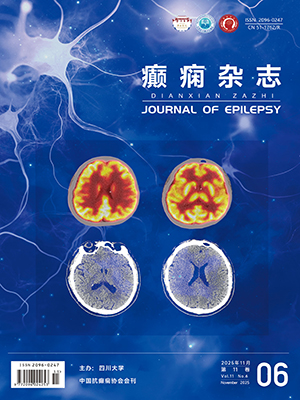| 1. |
Thijs RD , Surges R , O'Brien TJ, et al. Epilepsy in adults.The Lancet, 2019, 393(10172): 689-701.
|
| 2. |
Zhang CQ, Li YH, Wan Y, et al. effect of different physical activity training methods on epilepsy: a protocol for systematic review and meta-analysis. Medicine, 2022, 101(11): 1-3.
|
| 3. |
Branford D , Sun JJ , Burrows L , et al. Patterns of antiseizure medications prescribing in people with intellectual disability and epilepsy: a narrative review and analysis. British Journal of Clinical Pharmacology, 2023, 89(7): 2028-2038.
|
| 4. |
Watkins L , Máire O'Dwyer, Kerr M , et al. Quality improvement in the management of people with epilepsy and intellectual disability: the development of clinical guidance. Expert Opin Pharmacother, 2020, 21(2): 173-181.
|
| 5. |
Liao P, Vajdic CM, Reppermund S, et al. Mortality rate, risk factors, and causes of death in people with epilepsy and intellectual disability. Seizure, 2022, 101: 75-82.
|
| 6. |
Spiciarich MC , Gaudecker JRV , Jurasek L , et al. Global health and epilepsy: update and future directions. Current Neurology and Neuroscience Reports, 2019, 19(6): 30.
|
| 7. |
Tschamper MK, Systad S. Rare epilepsy-related disorder including intellectual disability-a scoping review of caregivers' identified information needs. Intellect Disabil, 2022, 26(3): 704-717.
|
| 8. |
Snoeijen-Schouwenaars FM , Young C , Rowe C , et al. People with epilepsy and intellectual disability: more than a sum of two conditions. Epilepsy & Behavior, 2021, 124: 108355.
|
| 9. |
Watkins LV, Pickrell WO, Kerr MP. Treatment of psychiatric comorbidities in patients with epilepsy and intellectual disabilities: is there a role for the neurologist? Epilepsy & Behavior, 2019, 98(Pt B): 322-327.
|
| 10. |
Michaelis R , Tang V , Wagner JL , et al. Psychological treatments for people with epilepsy. The Cochrane Database of Systematic Reviews, 2020, 8(8): 1-11.
|
| 11. |
Edward KL , Cook M , Giandinoto JA . An integrative review of the benefits of self-management interventions for adults with epilepsy. Epilepsy & Behavior, 2015, 45: 195-204.
|
| 12. |
聞以譯. 以家庭為中心的護理模式對癲癇患兒家庭功能及軀體健康狀況的影響. 當代護士: 下旬刊, 2020, 27(12): 83-84.
|
| 13. |
Camfield PR , Andrade D , Camfield CS , et al. How can transition to adult care be best orchestrated for adolescents with epilepsy?. Epilepsy & Behavior, 2019, 93: 138-147.
|
| 14. |
Kanhere S, Joshi SM. Transition of care in epilepsy. Indian Journal of Pediatrics, 2023, 90(11): 1127-1133.
|
| 15. |
Cui C, Zhou H, Chen W, et al. Behavioral dilemmas and support requirements of self-management for chinese adolescents with epilepsy during transition readiness: a mixed-methods study. Patient Preference and Adherence, 2023, 25(17): 2605-2619.
|
| 16. |
Fleeman N, Bradley PM, Panebianco M, et al. Care delivery and self-management strategies for children with epilepsy. The Cochrane Database of Systematic Reviews, 2022, 4(4): 1-9.
|
| 17. |
Lawal M. Self-care strategies for children with epilepsy. Evidence-Based Nursing, 2023, 26(3): 96-97.
|
| 18. |
魏超. 癲癇的護理體會與指導. 實用臨床護理學電子雜志, 2019, 4(27): 189.
|
| 19. |
Brandl U. Transition to adult care for patients with epilepsy. Der Nervenarzt, 2022, 93(4): 359-365.
|
| 20. |
Newman H , Rudra S , Burrows L , et al. Who cares? A scoping review on intellectual disability, epilepsy and social care . Seizure, 2023, 107: 35-42.
|
| 21. |
張蓮芳, 彭翠清, 馬廉亭. 癲癇持續狀態的急救和護理. 中國臨床神經外科雜志, 2023, 28(4): 279-280.
|
| 22. |
Siegel C, Armstrong TS. Nursing guide to management of major symptoms in patients with malignant glioma. Seminars in Oncology Nursing, 2018, 34(5): 513-527.
|
| 23. |
王巖, 諶婧, 馮小娟, 等. 綜合護理干預在兒童癲癇患者護理中的應用效果. 中外女性健康研究, 2023, 14(1): 1-2.
|
| 24. |
徐麗, 劉美麗, 譚玲芳, 等. 基于自我效能理論的遠程護理干預對學齡期癲癇患兒的實施效果. 護理實踐與研究, 2023, 20(20): 3125-3129.
|




